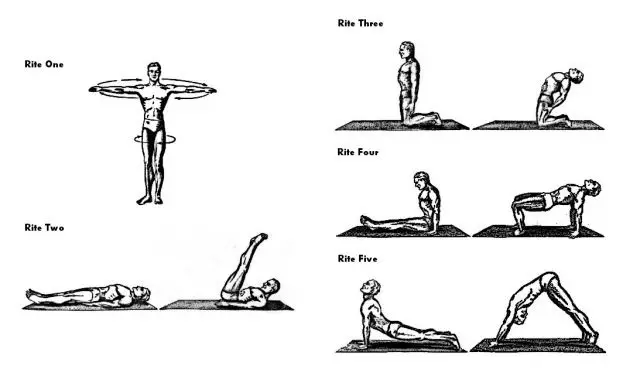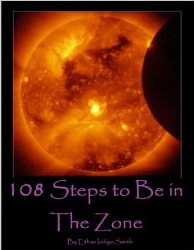The Five Tibetans:
The Ancient Tibetan Practice for
Health and Vitality
How Ten minutes a Day can change your Life
So what are the Five Tibetans?
The Five Tibetans or the Five Rites of Rejuvenation, is a system of five, believed to be Tibetan, Yogic exercises said to be over 2500 years old. You flow through the five exercises almost in a meditative dance. Each exercise stimulates a particular chakra or hormonal system and revitalises certain organs, so that the five rites together form a complete workout for the body as a whole.
This series of movements also known as “The fountain of youth” are credited with the ability to heal the body, balance the chakras and reverse the ageing process in just ten minutes a day.
According to legend, a British explorer learned the rites in a Himalayan Monastery from Tibetan monks who had excellent health despite their advanced age. Some skeptics cast doubt upon the origins of the practice, but no matter the exact source, there is no uncertainty about the great health benefits of the practice. Peter Kelder first publicised the Tibetan Rites in 1939 in a publication, The Eye of Revelation. The sequence was later popularised through a book, The Five Tibetans, written by yoga teacher Chris Kilham, who says we will never know their true origins:
“Perhaps they come from Nepal or Northern India…As the story has it, they were shared by Tibetan lamas; beyond that I know nothing of their history. Personally, I think these exercises are most likely Tibetan in origin. The issue at hand, though, is not the lineage of the Five Tibetans. The point is [their] immense potential value for those who will clear 10 minutes a day to practice.”
– Chris Kilham
Yoga teachers are in agreement, the sequence is a simple yet incredibly, even deceptively powerful one that creates a dynamic energetic effect in the body increasing the flow of prana or chi up the spine and through the chakras, energising every cell in your body.
Turning back the clock
According to the Tibetan lamas, the only difference between youth and old age is the spin rate of the chakras (the body’s seven major energy centres).This specific routine is said by lamas to stimulate all seven chakras to spin rapidly at the same rate. They believe that if any one of the chakras is blocked and its natural spin rate slowed, then vital life energy will be unable to circulate and so ageing and illness will set in. The Five Tibetans are called the rites of rejuvenation because the lamas say the ageing process is stopped by the unblocking and activation of the spinning of the chakras due to this sequence. Recent medical research has uncovered convincing evidence that the ageing process is hormone-regulated.The sequence also normalises hormonal imbalances in the body which also hold the key to lasting youth, vitality and wellbeing.
As simple as the Five Tibetans may seem, they have a profound effect on the energy and chakra system of the body, stimulating the electrical energy of the chakras in the same way as switching on a light switch sets off a flow of electrical energy.
“The Five Tibetans is simple, practical, effective and certainly mind/body altering. If you would love to become rejuvenated, remain calm, feel more vitality, be more flexible and simply look your absolute best, then now there is a new way to experience a greater state of wellbeing that takes just minutes a day, but lasts a lifetime.”
… Dr. John F. Demartini
How to practice the Five Tibetans
The Five Tibetans have similarities to some traditional yoga practices: Tibetan 1 is basically Sufi whirling. Tibetan 3 is essentially the camel pose. Tibetan 4 is like an upward table, and Tibetan 5 is a smooth flow of up dog and down dog
First Tibetan
Stand erect with arms strong, outstretched and horizontal with the shoulders. Now spin around in a clockwise direction until you become slightly dizzy. You can employ a ballet-like technique of keeping your eyes on one spot and then returning to that spot when you turn your head in a full revolution.There is only one caution: you must turn from left to right.
Breathing: Inhale and exhale deeply as you do the spins.
Second
Tibetan
Lie down full length on the floor or bed. Place the hands flat down alongside of the hips. Fingers should be kept close together with the finger-tips of each hand turned slightly toward one another. Raise the feet until the legs are straight up. If possible, let the feet extend back a bit over the body toward the head, but do not let the knees bend. Hold this position for a moment or two and then slowly lower the feet to the floor, and for the next several moments allow all of the muscles in the entire body to relax completely. Then perform the Rite all over again. For greater core strength activation you can lower the legs without touching the floor and then using your belly and your in breath, raise the legs up, in a continuous cycle. Be sure to breath out as you lower the legs. An easier version is to have your hands underneath the buttocks and a more challenging version is to have the arms stretched above the head as you raise your legs.
Breathing: Breathe in deeply as you lift your head and legs and exhale as you lower your head and legs.
Third
Tibetan
Kneel on the floor with the body erect. The hands should be placed on the backs of your thigh muscles. Incline the head and neck forward, tucking your chin in against your chest. Then fold the the head and neck backward, arching the spine. Your toes should be curled under through this exercise. As you arch, you will brace your arms and hands against the thighs for support. After the arching return your body to an erect position and begin the rite all over again.
Breathing: Inhale as you arch the spine and exhale as you return to an erect position.
Fourth
Tibetan
Sit erect on the floor with your feet stretched out in front of you. The legs must be perfectly straight, with the backs of the knees well down or close to the floor. Place the hands flat on the rug, fingers together, and the hands pointing outward slightly. Chin should be on chest and the head forward. Now gently raise the body on an in breath, using your core strength of your belly to lift the pelvis, and at the same time bend the knees so that the legs from the knees down are practically straight up and down like an upward table. The arms, too, will also be vertical while the body from shoulders to knees will be horizontal. As the body is raised upward allow the head gently to fall backward so that the head hangs backward as far as possible when the body is fully horizontal. Hold this position for a few moments, return to first position on the out breath, and relax for a few moments before performing the Rite again. When the body is pressed up to complete horizontal position, you can tense every muscle in the body.
Breathing: Breathe in as you raise up, hold your breath as you tense the muscles, and breathe out fully as you come down.
Fifth
Tibetan
Place the hands on the floor about two feet apart. Then, with the legs stretched out to the rear with the feet also about two feet apart in a downward dog, push the body, and especially the hips, up as far as possible, rising on the toes and hands. At the same time the head should be brought so far down that the chin comes up against the chest. Next, allow the body to come slowly down to a ‘sagging’ position in an upward dog, with only the toes on the floor. Bring the head up, causing it to be drawn as far back as possible. The muscles should be tensed for a moment when the body is at the highest point, and again at the lowest point.”Be sure not to strain the lower back, by bringing strong flowing movement to the upper shoulders. Those with lower back injuries can bend the legs as they go into upward dog.
Breathing: Breathe in deeply as you raise the body, and exhale fully as you lower the body.
Gain a more focused and purposeful mind
As with all yoga practice, it is important to synchronise your breath with the movement. It’s best to do the exercises in the morning because they get your energy going. But it’s highly likely you will fall in love with the sequence and want to repeat it during the day. To begin with it is best to complete five to seven repetitions of each rite every day and to work up to 21 repetitions of each of the exercises. Usually this takes about 10 – 12 weeks. A lot of people are keen to reach 21 repetitions quickly, but it is best to gradually increase the repetitions. The recommended slow build up process allows your body to develop a strong foundation upon which to improve your flexibility. And it also is important due to the effects of the Rites themselves. They can initiate many changes in your bodies energy and balance systems. Although this varies from person to person, it is generally best to allow your body time to adjust.
It’s important to pay attention to what your body is telling you and not to strain or force any position that causes pain. There is also a simple and adapted version of the Five Tibetans for those who have injuries or cannot perform the sequence.
When you make this sequence part of your daily practice, you can experience an overall improvement in your health and wellbeing and perhaps the most important benefit, is a dramatic increase in your levels of energy. Other great benefits are a greater resilience to stress and the ability to stay centred. As with all yoga practice greater flexibility in body and mind are usual. Most people report a more focused and purposeful mind and greater awareness, which then creates a happier and more fulfilling life. This sequence really improves the quality of your life.
A complete and balanced practice
One of the great things about the Five Tibetans, is it is a quick and simple practice that can be done by anyone, regardless of age or fitness levels. It is an incredibly simple ten minute routine that can easily be slotted into your daily life, yet will have major spin offs in all areas. Its free, and its yours. A self empowering practice you can do on your own anywhere and at any time! The Five Tibetans strengthens and stretches all the main muscles in the body. Just as Sun Salutations make up a complete sequence, the Five Rites are a complete and balanced practice.
The 5 Tibetan Rites
- Reduce stress
- Feel younger and more powerful
- Slow down the aging process
- Improve strength and flexibility
- Enhance vitality
- Calm the mind
- Create greater mental clarity and focus
- Improve your breathing so its deeper, slower and conscious
- Strengthen lower back and core muscles
- Improve your libido
- Supports menopause and hormonal balance
- Be more centred and at peace
- Lose weight and develop muscle tone and core strength
- Improved digestion and elimination
- Reduce depression and anxiety
- Develop better posture
- Strengthen your immune system
- Support deeper sleep
From Uplift @ http://upliftconnect.com/the-five-tibetans/
The 5 Tibetan Rites of Rejuvenation: 108 Movements to a Meditative Mind State
It
just so happens that one of the quickest and simplest sets of meditative
movements
and one of the easiest to integrate as your own, is also one of the most
powerful. The Five Tibetan Rites of Rejuvenation take about twenty minutes or
so depending on how long you meditate, the longer the better of course.
There
are many ways to do the Five Tibetans and the movements will benefit you in
multiple ways also. As with all meditative movements, part of the reason people
are adverse to beginning it – part of the reason we allow our ego to convince
us we do not need to do such practices – is because we see that they take time.
But remember meditative movements make time, they give you more energy and more
efficiency.
The
Five Tibetan Rites of Rejuvenation were not designed as beginner yoga, nor are
they, but the fact they only take twenty minutes or so makes them totally
accessible to our busied mind and active lifestyle that prevents us beginner yogis
from beginning. I have described some finer points of each in the following.
5 Tibetan Rites of Rejuvenation
There
are 5 movements done 21 times and 1 movement done, most frequently, 3 times, equating to 108
breath coordinated movements. Each of the Tibetans are followed by taking two
breaths so as to balance out the energy just moved. The Sixth Tibetan is only
performed after you are capable of doing 21 breath coordinated movements of the
Five Tibetans and doesn’t have to be included otherwise. One can begin doing
any number of each Rite that you feel comfortable with, but try to do an equal
number of each.
The
first Tibetan is
simply spinning clockwise with the arms active to the sides. The first Rite is
done clockwise in unison with the sun for the chakras are said to spin
clockwise. When held up such activates and opens up the arms, shoulders and
neck. Try going excruciatingly slow. The Five Rites strengthen and activate the
abdominal area and neck. These areas are considered the most problematic and
clogged in terms of energetic and chakra understandings too. The Rites open up
the chakras.
Then
take two breaths like Superman, that which devoted practice can turn you into.
Hands are at your hips. Take a deep breath through your nose and exhale through
your mouth with lips shaped in an O like Superman blowing out cold air.
The
trick to the second Tibetan
is to lift up and set down the legs and neck in unison. Each Tibetan is done in
unison with the breath and as with all meditative movement, the inhale is
tension/activation and exhale is relaxation/release. So each movement begins
with inhale and returns with exhale. The easiest way to count is to count 1 on
the inhale and 1 on the exhale, counting each twice so you are less likely to
lose track.
A
trick with the third Tibetan
is to think about using your hands as support and about bringing bring your
back so that it returns to being perpendicular or just slightly past
perpendicular, a degree or two forward. Go slow.
The
trick to the fourth Tibetan
is to initiate the movement with your neck opening the throat chakra.
As
you progress you will eventually be able to do the fifth Tibetan with opened joints and
ligaments doing Hindi pushups where your face glides along just above the floor
and then rises up, like a cobra, on the return/release.
Remember
to breathe twice like Superman in between each Rite.

The 6th Tibetan
The
trick with the sixth Tibetan
is to not do it unless you can do 21 of each of the first Five. I find three of
the sixth Tibetan is optimal and no more than five is advised. For more
specifics on the Five Tibetan Rites check out 108 Steps to Be in The Zone
108 Steps to Be In The Zone
 Want to learn
more about the metaphysical relationship of 108, and how it can help you live
“in the zone”? Check out Ethan Indigo Smith’s book 108 Steps to Be in The Zone.
Want to learn
more about the metaphysical relationship of 108, and how it can help you live
“in the zone”? Check out Ethan Indigo Smith’s book 108 Steps to Be in The Zone.
In
this work, Ethan provides a set of 108 meditative practices and steps
toward self discovery and individual betterment, including techniques to
develop balance, transmute sexual energy and better the self.
“Ethan’s work on meditation achieves a level of
rarefied quality so necessary to metaphysical writing and teaching.
The 108 Steps is simple and profound, and rich in details and analogies that
bring the inner truths of diverse traditions into usefulness in the present
time. Ethan’s writing… lays out a system that can be used beneficially to
reveal one’s inner nature and the truths we all seek sooner or later.” ~
Laura Peppard, Founder and Director of the Reno Psychic Institute.
“108 Steps to Be in The Zone” is available here on
Amazon.com.
About
the author:
 Author,
activist and Tai Chi teacher Ethan Indigo Smith was born on a farm in Maine and
lived in Manhattan for a number of years before migrating west to Mendocino,
California. Guided by a keen sense of integrity and humanity, Ethan’s
work is both deeply connected and extremely insightful, blending philosophy,
politics, activism, spirituality, meditation and a unique sense of humour.
Author,
activist and Tai Chi teacher Ethan Indigo Smith was born on a farm in Maine and
lived in Manhattan for a number of years before migrating west to Mendocino,
California. Guided by a keen sense of integrity and humanity, Ethan’s
work is both deeply connected and extremely insightful, blending philosophy,
politics, activism, spirituality, meditation and a unique sense of humour.
Ethan’s publications include:
- Tibetan Fusion a book of simple meditative practices and movements that can help you access and balance your energy.
- The Little Green Book of Revolution an inspirational book based on ideas of peaceful revolution, historical activism and caring for the Earth like Native Americans.
- The Matrix of Four, The Philosophy of the Duality of Polarity on the subject of the development of individual consciousness
- 108 Steps to Be in The Zone a set of 108 meditative practices and steps toward self discovery and individual betterment, including techniques to develop balance, transmute sexual energy and better the self.
- The Complete Patriot’s Guide to Oligarchical Collectivism, an insightful exploration of history, philosophy and contemporary politics.
- The controversial book, Terra-ist Letters, a work that humorously contrasts the very serious issues of global nuclear experimentation promotion and global marijuana prohibition
For
more information, visit Ethan on Facebook and check out Ethan’s author page on Amazon.com
From Wake Up World @ http://wakeup-world.com/2013/06/13/the-five-tibetan-rites-of-rejuvenation/
For more information about yoga see http://nexusilluminati.blogspot.com/search/label/yoga
- Scroll down
through ‘Older Posts’ at the end of each section
Do you LIKE this uniquely informative site?
A genuinely incapacitated invalid maintains, writes, edits,
researches, illustrates, moderates and publishes this website from a tiny cabin
in a remote forest.
Now that most people use ad blockers and view these posts
on phones and other mobile devices, sites like this earn an ever shrinking
pittance from advertising sponsorship.
This site needs your help.
Like what you see? Please give
anything you can -
Contribute any amount and receive at least one New Illuminati eBook!
(You can use a card securely if you don’t use Paypal)
Please click below -
And it costs nothing
to share this post on Social Media!
Dare to care and
share - YOU are our only advertisement!
Video - https://youtu.be/n1sePkZlJXc
For further enlightening
information enter a word or phrase into the random synchronistic search box @
the top left of http://nexusilluminati.blogspot.com
And see
New Illuminati – http://nexusilluminati.blogspot.com
New Illuminati on Facebook - https://www.facebook.com/the.new.illuminati
New Illuminati Youtube Channel - https://www.youtube.com/user/newilluminati/playlists
New Illuminati’s OWN Youtube Videos
-
New Illuminati on Google+ @ For
New Illuminati posts - https://plus.google.com/u/0/+RamAyana0/posts
New Illuminati on Twitter @ www.twitter.com/new_illuminati
New Illuminations –Art(icles) by
R. Ayana @ http://newilluminations.blogspot.com
The Her(m)etic Hermit - http://hermetic.blog.com
DISGRUNTLED SITE ADMINS PLEASE NOTE –
We provide
a live link to your original material on your site (and links via social
networking services) - which raises your ranking on search engines and helps
spread your info further!
This site
is published under Creative Commons (Attribution) CopyRIGHT (unless an
individual article or other item is declared otherwise by the copyright
holder). Reproduction for non-profit use is permitted & encouraged - if you
give attribution to the work & author and include all links in the original
(along with this or a similar notice).
Feel free
to make non-commercial hard (printed) or software copies or mirror sites - you
never know how long something will stay glued to the web – but remember
attribution!
If you
like what you see, please send a donation (no amount is too small or too large)
or leave a comment – and thanks for reading this far…
Live long
and prosper! Together we can create the best of all possible worlds…
From the New Illuminati – http://nexusilluminati.blogspot.com


Great article, thank you! I love the Five Tibetans ❤️
ReplyDeleteMuchos Gracias for your post. Really looking forward to read more. Want more... MM
ReplyDeleteMajor thanks for the post. Really looking forward to read more. Really Great... MM
ReplyDeleteI truly like your technique. Good day very cool blog!! Man .. Excellent .. Superb... MM
ReplyDeleteHello very nice article!! Excellent & Wonderful. I’ll bookmark this website... MM
ReplyDeleteVery informative and helpful. Thanks for sharing and keep sharing... MM
ReplyDeleteSuch great & useful information here. Your posts are very informative. Thanks!... MM
ReplyDelete
ReplyDeleteThis article is really contains lot more information about This Topic. Its great